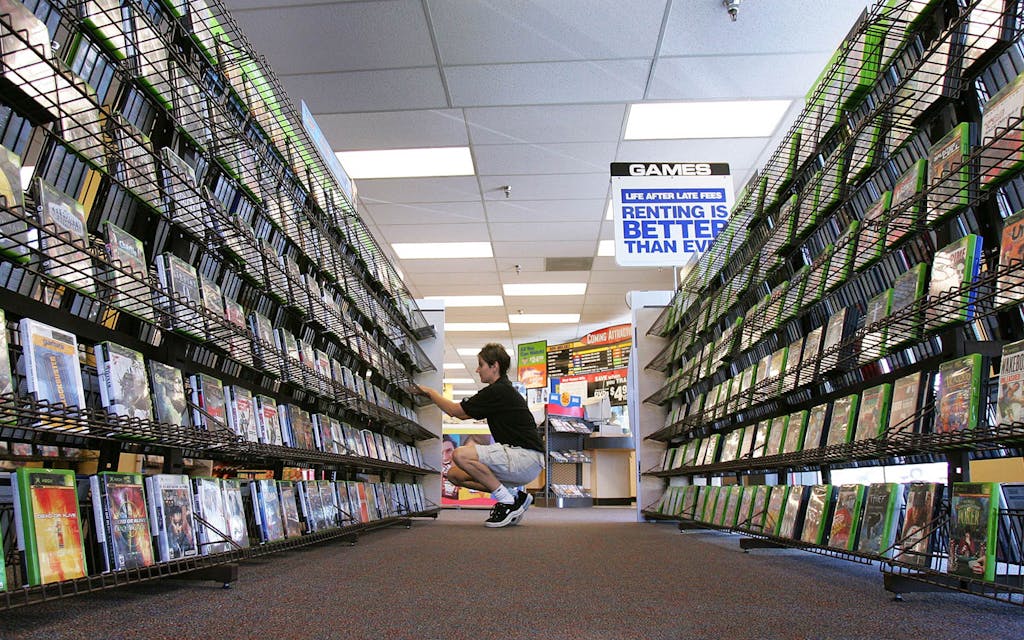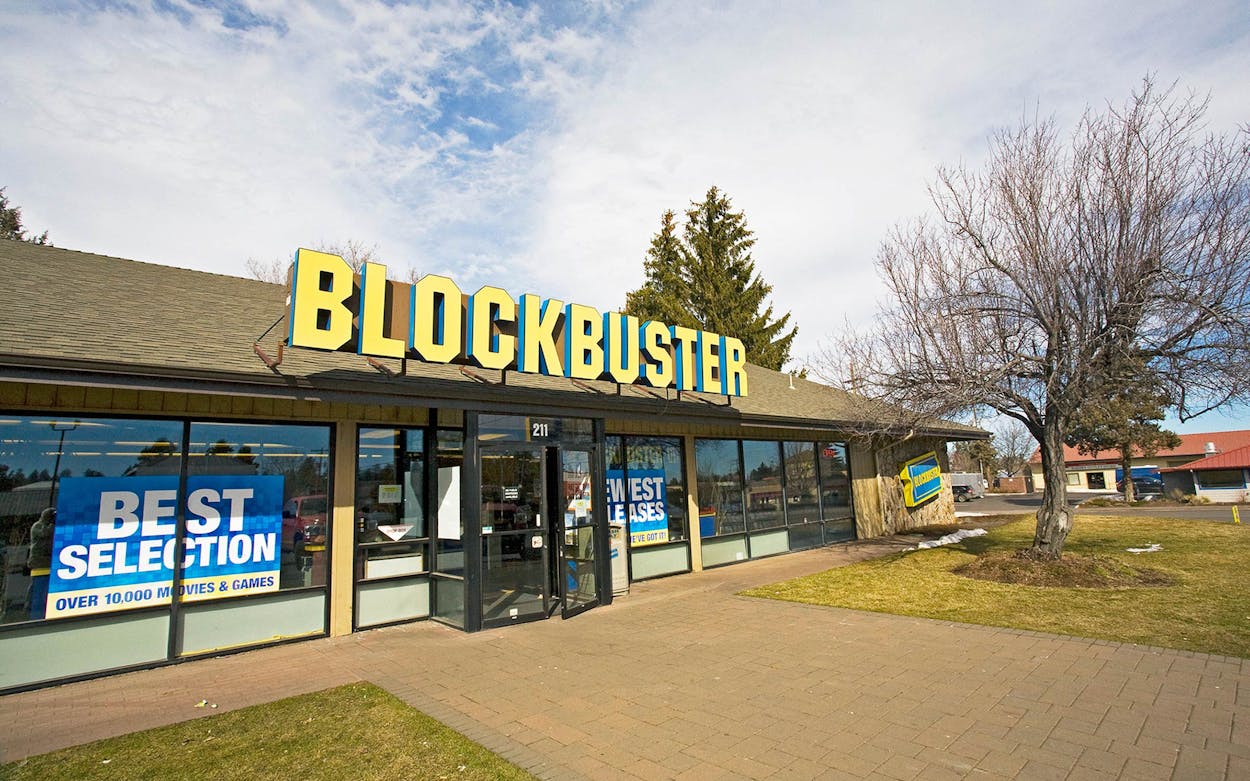In the summer of 2000, when I was sixteen, I went to work at Blockbuster Video for $5.15 an hour. Founded in Dallas in 1985, the chain peaked in 2004, when it had more than nine thousand locations across the country. With its dorky, blue-and-yellow employee uniforms and family-friendly vibe, Blockbuster had a reputation as a comically lame slice of American culture, and I don’t disagree. But to a kid from the piney woods of Longview, with a nascent interest in subcultures, it meant everything.
My job was easy and mostly mundane. I spent hours popping open plastic clamshell cases, inserting videos into rewinding machines, and shelving movies. But I also learned how to appreciate many directors’ entire oeuvres—even if I did find the movies tucked away on a dusty shelf and not enshrined in their own sections, as in the independent video stores I would frequent later in college. Early brushes with Alfred Hitchcock and David Lynch paved the way for my later interest in Michelangelo Antonioni and Werner Herzog. I recommended Quentin Tarantino’s tour de force Pulp Fiction, Tim Burton’s quirky biopic Ed Wood, or Wes Anderson’s oddball comedy Bottle Rocket. I probably rolled my eyes when some customer was disappointed that all 98 copies of The Fast and the Furious were checked out. With my employee discount, I purchased old and unwanted movies for just $1.99 each, amassing a decent VHS collection that my partner now attempts to persuade me to throw away.

Working at Blockbuster came with a modicum of status in a town as boring as Longview. The coolest kids were somewhere drinking in a pasture on the tailgate of a truck, but a small cadre of wannabe artists sometimes gathered at my house to watch one of my five free movie rentals per week. Six or seven of us sprawled across the white carpet of my living room floor watching Fargo or American Beauty or L.A. Confidential or Plan 9 From Outer Space, believing that we were far cooler than we were.
When I wasn’t hosting movie parties or discovering filmmakers, I performed menial tasks like keeping up with the call log. That meant dialing up numbers and reminding customers about overdue movies and late fees. (Most handwritten entries were coded “LMOM”—left message on machine.) Or nightly cleaning, when I learned to recognize the slightly sweet and decadent smell that crushed insects make when they’re vacuumed up. All the foot traffic in and out of the store, combined with the humid East Texas nights, meant multitudes of dead bugs at the end of the day.
Though Blockbuster was an uncool corporate machine, the movies I discovered there were so much more. I found a portal to seeing the world in a new way—one that felt more accepting of someone who didn’t feel entirely at ease in the small town in which I was born. Each blue VHS box was a transmission from another planet that promised there were others like me somewhere.
Turns out a lot of other people share my sentimental recollections. The new documentary The Last Blockbuster, now streaming on Netflix, is an affectionate tribute to the bygone video chain. Though it focuses closely on the sole remaining Blockbuster on the planet, located in Bend, Oregon, director Taylor Morden’s film also devotes some time to waxing philosophical about the value of physical media and the VHS era. It also corrects an oft-repeated piece of conventional thinking: according to the film, Netflix didn’t actually kill Blockbuster.

Blockbuster fans and nostalgic millennials will find plenty to admire about this movie. Over its 86 minutes, viewers can fondly recall reading the backs of movie boxes for hours, having to come to an agreement with a significant other, and smelling the unforgettable Blockbuster smell—a mix of popcorn, plastic, and carpet cleaner. They’ll also remember the frustration of late fees, a policy central to Blockbuster’s success as a business.
I remember the unmitigated fury that late fees evoked from suburban dads. Some video would emerge from beneath a teenage son’s bed weeks late, resulting in $40 or even $60 in fees. “That’s ridiculous!” the father would exclaim. “I’ll just pay for the movie; how much is it?” Customers had no idea that many of the movies were copies exclusively for rental stores and weren’t yet released to the wider public. They didn’t respond well when told that the movie cost about $100. We could usually defuse the situation by sharing the little-known fact that on select Wednesdays, we would cut late fees in half, no questions asked.
The backstory of this rental store pricing and how it emerged is explored in The Last Blockbuster, and is among its more fascinating elements. In a similar vein, the documentary briefly touches on the practice of “revsharing,” short for revenue sharing. Essentially, a corporate contract allowed Blockbuster to acquire copies of movies at lower prices, because the chain would eventually give back a portion of the rental revenue to the sellers. In effect, this destroyed the small, independently owned stores, which didn’t have such generous contracts and couldn’t afford fifty or one hundred copies of the latest films at $100 each.
Perhaps it’s an entirely separate endeavor to tackle the way Blockbuster killed independent video stores around the country, but it feels like a missed opportunity that the documentary doesn’t explore a more significant question about culture that parallels the death of the video store at large. Instead, the film traffics primarily in nostalgia, treating Blockbuster as a piece of memorabilia. Viewers lightheartedly traipse down memory lane with actors and comedians as their guides: Ione Skye, Brian Posehn, Doug Benson, and Jamie Kennedy all provide commentary. Despite some incisive and heavy moments, the tone often strikes a note of levity akin to that in VH1’s I Love the 80s. At best, the film offers an attempt at reclaiming some long-lost feeling of human connection, since we can no longer peruse the shelves of a video store (especially right now).
The documentary leads with a promise to reveal what really killed Blockbuster, considering that even as Netflix succeeded, Blockbuster had plenty of inventory and could have easily moved into similar markets to at least challenge its new competitor every step of the way. The Last Blockbuster delivers on its hook, even if the answer somewhat simplistically points a finger in the direction of the 2008 financial crisis. (Blockbuster had significant debt and was unprepared to weather the recession, while nimbler Netflix, without the high overhead costs of operating stores and hiring clerks, made it through just fine.)

In the end, I kept wondering why the film chose not to dig deeper into the economics and cultural implications of Blockbuster’s business practices. This might mean reckoning with the blind spots of our current streaming paradigm, and examining which shifting cultural or technological tides might spell its eventual demise. Or evaluating streaming’s effects on cinema, such as by examining Netflix’s noted dearth of classics or the accusation that the endless drive for content undermines quality. In The Last Blockbuster, media commentator Kate Hagen remarks on video stores’ similarity to libraries in terms of cultural value. It’s emotionally draining to think of thousands of libraries closing around the country, but that’s a fair approximation of what has happened.
With Blockbuster now an endangered species instead of a corporate ogre, it’s easy—even for cool directors such as Kevin Smith, who is featured prominently in Morden’s documentary—to get nostalgic about something that would have been ubiquitously scoffed at by serious film geeks in the early aughts. It says something about how much our mindset has changed, and how comfortable we’ve become with a handful of companies acting as arbiters of culture.
Streaming services are undeniably convenient and easy, but I miss the experience of interacting with a human. Blockbuster, even in its corporate sterility, employed tens of thousands of people who were eccentric enough to recommend a wide array of films. That human touch comes through in The Last Blockbuster, especially with Sandi Harding and her family, who manage the final remaining store in Oregon. If you want a movie in Bend, and the Blockbuster doesn’t have it, Sandi buys it to put on the shelf. The significance she and her staff place on their store and on the loyal customers who rent from them is the film’s greatest asset.
Like most commentators in the documentary, I miss video stores. But it’s more than that. As I watched the film, I found myself missing a world that never existed—one in which we hold on to what best serves people culturally and emotionally, and not a world that makes decisions exclusively based on the revenue generated at a given moment. If we could spend dopamine like dollars, video stores would still exist. We often falsely believe that if people enjoy something there will be a market for it, but if a service’s utility can be equalled or surpassed, enjoyment is no match for profit. In that regard, it’s nice to see the Blockbuster in Bend getting by, even if it depends on Dish (which owns the Blockbuster name) to renew its licensing agreement each year. Looking back, I see that Blockbuster wasn’t good or cool, but it was meaningful—a flickering screen telling me there was a world out there waiting to be found.
- More About:
- Film & TV
- Documentary
- Longview
- Dallas






